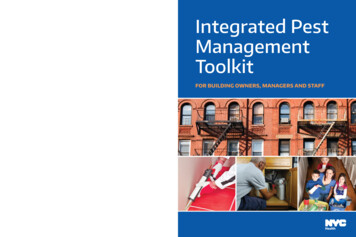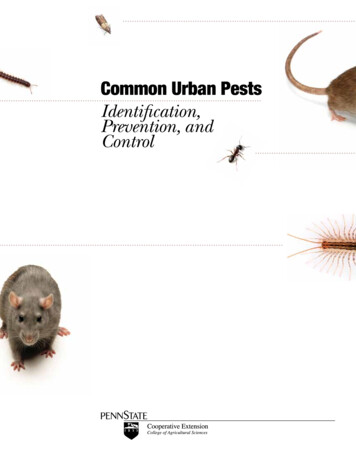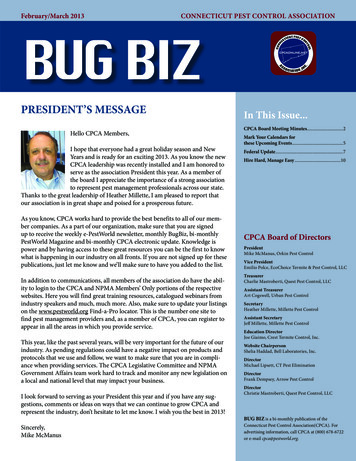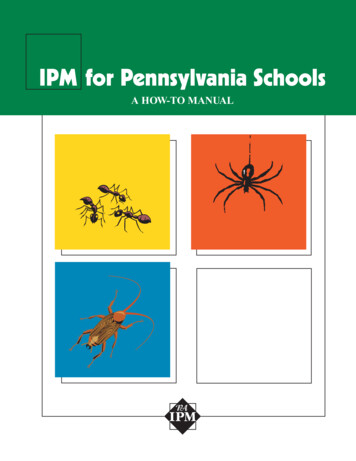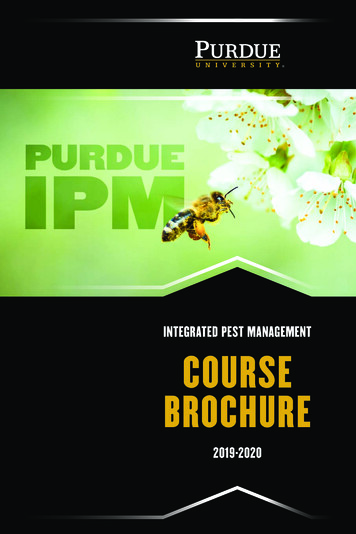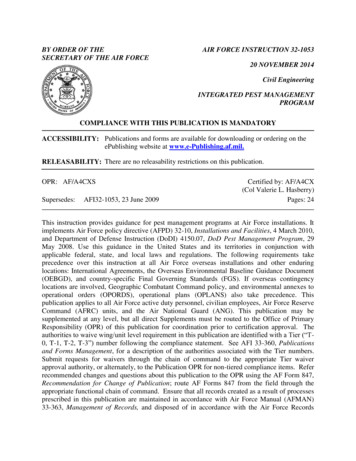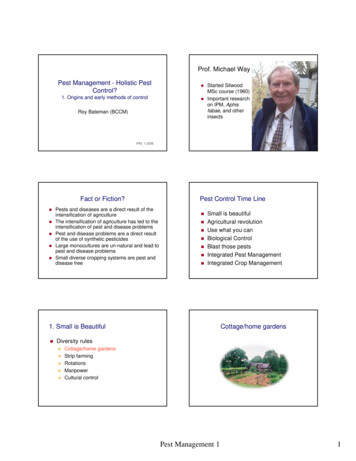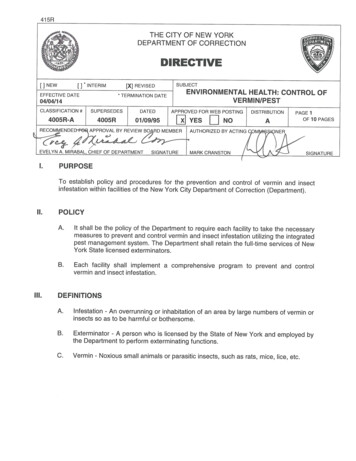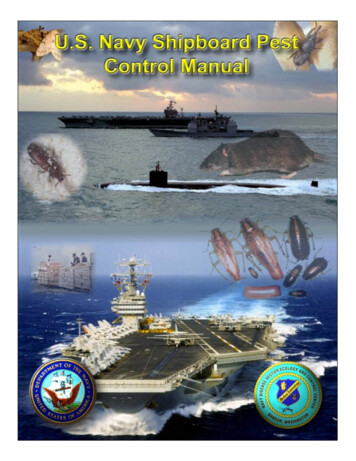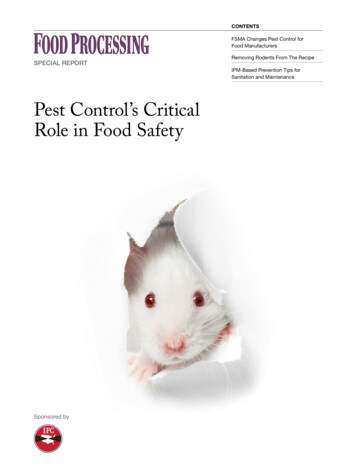
Transcription
Problem Prevention andHolistic Pest ManagementThomas D. Landis, Tara Luna, R. Kasten Dumroese, and Kim M. Wilkinson14As any experienced grower knows only too well, nursery management is a continuous process of solving problems. One recurring problem is pests. In the past,nursery managers waited for an insect or disease to appear and then sprayed sometoxic chemical to wipe out the pest or disease. This approach, however, also wipesout natural predators of the pest, resulting in an expensive and repeating pesticidecycle. Instead of a knee-jerk reaction to a specific problem, “holistic” pest management is a series of interrelating processes that are incorporated into the entirespectrum of nursery culture. Holism is the theory that systems, and each part of asystem, should be viewed as a whole and not as isolated parts. “Holistic,” then, is anapproach that looks at the big picture and considers all parts. Holistic pest management is an integrated and preventative approach that considers the overall healthof the plant and the nursery environment to prevent problems and to manage themwisely if they arise. The holistic approach to nursery pest management involves aseries of four interrelated practices, which ideally function together (Wescom 1999): Problem Prevention Through Cultural Measures—through good sanitation,proper scheduling, management of the nursery environment, and promotionof plant health. Problem Detection and Diagnosis—through monitoring, recordkeeping, andaccurate problem identification. Problem Management—including, if necessary, timely and appropriate pestsuppression measures and balance of pest populations with beneficialorganisms and pest predators. Ongoing Process Evaluation—to learn from experience by assessment andimproved effectiveness of pest management approaches.Facing Page: Beneficial insects are an important part of holistic pest management. The ladybugs (Hippodamia species[Coleoptera: Coccinellidae]) in this photo can be seen feeding upon the psyllid pest Heteropsylla cubana (Hemiptera: Psyllidae).Photo by J.B. Friday.273
ABDGIECFHKJLMFigure 14.1—A collage of biotic nursery pests. Fungal pests include damping-off (A), Phytophthora root canker (B), fungal rust onō‘hi‘a leaves (C), and Botrytis blight (D). Insect pests include aphids (E), fungus gnat larvae eating seeds (F) and roots (G), leaf miners(H), mealybugs on palm (I), and mites making leaf galls (J). Snails and slugs (K) can damage nursery plants. Plants such as weeds, liverworts, and algae (L, M) can smother small plants. Photos A through J by Thomas D. Landis, photo K by Brian F. Daley, photo L by R.Kasten Dumroese, and photo M by William Pink.274Tropical Nursery Manual
Nursery Diseases and PestsNurseries have many potential pests, including fungi(figures 14.1A–14.1D), insects (figures 14.1E–14.1J),nematodes, snails, slugs (figure 14.1K) and even largeranimals such as mice and deer. Other plant species, suchas weeds and cryptogams (moss, algae, or liverworts)(figures 14.1L, 14.1M) can become pests when they compete with crop plants for growing space and light.Plant disease can also be caused by abiotic (environmental) stresses, including heat (figures 14.2A, 14.2B),light (figure 14.2C), and too much or too little water (figures 14.2D, 14.2E). Sometimes, people are pests when theymisuse chemicals such as applying too much lime (figure14.2F) or fertilizer (figure 14.2G).A useful concept to explain nursery pest problemsis the “disease triangle,” which illustrates the interrela-Ationships among the pest, host, and environment (figure14.3). All three factors are necessary to cause biotic disease. For example, a fungus or insect pest is able to survive inside the warm greenhouse environment and attackthe host plant. Although many diseases may appear toinvolve only the host plant and the biological pest, environmental factors are always involved. Environmentalstress may weaken the plant and predispose it to attackby the pest, or a particular environment may favor pestpopulations, enabling them to increase to harmful levels.Abiotic disease can be visualized as a two-way relationshipbetween the host plant and adverse environmental stress(figure 14.3). Abiotic diseases may develop suddenly as theresult of a single injurious climatic incident, such as a heatwave or dust storm, or more gradually as a difficult-to-detectgrowth loss resulting from below-optimum environmentalfactors, such as a mineral nutrient deficiency.BCDFGEFigure 14.2—Abiotic disease can be caused by any excessive environmental stress,including heat injury to germinants (A), or sunscald of mature foliage (B). Exposingshade-loving plants, like these Norfolk Island pine, to full sunlight can damage theirability to photosynthesize (C). Irrigating too much can lead to high humidity and condensation (D), which predisposes plants to many bacterial and fungal pests. Too littleirrigation causes wilting (E), which inhibits growth. Overliming of growing media (F),misapplication of pesticides, or improper fertilization (G) can cause chemical injuries.Photos by Thomas D. Landis.Problem Prevention and Holistic Pest Management275
can prevent these animals from becoming problems and alsokeeps out any diseases and pests they might bring in on theirbodies. Vegetation adjacent to nurseries should be assessedto see how it might positively or negatively affect nurseryplant health. For example, a nearby hedge consisting only ofmahogany trees infested with the local mahogany shoot borermay increase the likelihood of these pests entering the nursery and affecting a crop of mahogany seedlings. Well-plannedadjacent vegetation in hedgerows and windbreaks can provide refuge for beneficial organisms, however, includingpollinators and pest predators such as ladybugs, predatorywasps, spiders, amphibians, and birds.Pests generally enter the nursery growing area throughthe following modes:Figure 14.3—The “disease triangle” illustrates the concept thata host, a pest, and a conducive environment are necessary to causebiotic disease. Abiotic disease occurs when environmental factors,like excessive moisture or heat, injure the host plant. Illustrationadapted from Dumroese and others (2008).Problem Prevention ThroughCultural MeasuresPreventing problems is better than having to deal withthem after symptoms occur. Prevention steps include maintaining good sanitation and hygiene in the nursery, propercrop scheduling to avoid diseases and health problems inholdover stock, and promoting plant health through goodnursery management.Good SanitationThe most logical approach to disease management is toprevent diseases by excluding pests from the growing area. Alldiseases are much easier to prevent than to cure. Sanitationbegins with nursery site selection and preparation.A source of clean water for irrigation is one of the key considerations in site selection. Some water sources harbor damping-off fungi including Pythium and Phytophthora (Jaenicke1999) and need to be avoided if possible. (Treating water maybe an option; see Chapter 11, Water Quality and Irrigation.)A weed-free fabric groundcover or concrete floor under nursery benches can also be instrumental in preventing problems.In contrast, having bare soil under plants can allow soilpathogens to splash or blow onto nursery plants and can bea favorable environment for weeds. Weeds near or underbenches may provide cover for insect pests including thrips,aphids, whiteflies, and weevils. Weeds can also be a source ofpathogenic fungi, such as Fusarium (James 2012). Excludingseed-eating rodents and birds with screens or other barriers276 Wind—Airborne fungal spores, seeds, or insects canbe introduced on the wind. Water—Fungus and cryptogam spores and weedseeds can be introduced through irrigation water. Growing Media—Most growers try to use growing media components that are free from pathogens.However, potentially harmful fungi can sometimes beisolated from some growing media components. Whentopsoil is used as the growing medium, or as part of amix, it can carry a variety of insect, fungal, and weedpests to the nursery. See Chapter 6, Growing Media, formore information about the risks associated with usingsoil as the growing medium. Containers—Reusable containers may containresidual growing medium or plant roots that harborpotentially pathogenic fungal propagules, moss, oralgae. Surfaces in the Growing Area—Floors, benches, andother surfaces in the growing area may harbor pests. Propagation Materials—Seeds, transplants, or cuttings are sometimes contaminated before they reachthe nursery. Importing plants from other nurseriesposes a very high risk of introducing new pests. If theplants have been imported from other islands, thisposes a risk not only to the nursery but to the entireisland ecosystem as well. Imported nursery stock hasbeen the culprit for introducing several invasive pestsand plants into island ecosystems. Transported Pests—Infested soil or other materialscan be carried into the growing area on tools, equipment, or the shoes of workers or visitors. Mobile Pests—Insects, birds, and rodents can enterthe growing area directly.Tropical Nursery Manual
Checklist for Preventing Diseases and Pests WithGood Sanitation Use hooks to keep the hose nozzles off the floor anddisinfect planting tools after each use. Start with clean seeds. Seeds can be rinsed with adiluted bleach or hydrogen peroxide solution beforestratification or sowing to help prevent seed and seedling diseases (see Chapter 9, Seed Germination andSowing Options). Keep plants off the floor and out of contact with soilif feasible. Elevating plants on benches, with a fabricgroundcover or concrete floor underneath, helps toreduce pest problems. Remove all plant debris from the nursery area beforesowing each crop. Also, clean tables, aisles, sidewalls,and floors with a mild bleach or soap solution beforesowing. Use precaution if importing plant material from othernurseries, especially from other islands. Importedplant materials should be certified pest free. Youwill ideally use only local, native, or traditional plantmaterials in your nursery to minimize the risk ofspreading insects, diseases, and invasive plants. Regularly and vigilantly remove all weeds growingunder benches and within the crop. Use containers that have been cleaned (see Chapter 7,Containers). Heat-pasteurize (steam or solarization) any growingmedia ingredients that may contain pests or diseases.Use soil-free media if possible (see Chapter 6, Growing Media). Prevent algae from forming on the floors and benchesby ensuring rapid drainage of excess irrigation waterand by properly managing irrigation frequency (seeChapter 11, Water Quality and Irrigation). Algae andpools of water provide a breeding ground for fungusgnats and shore flies and the slick surfaces can be asafety hazard to nursery staff.A Test nursery water for problems and treat if necessary.Proper SchedulingCrop scheduling is an important component of holisticpest management. A typical tropical plant nursery will begrowing a wide variety of plant sizes and species with different growth rates. For example, in Hawai‘i, koa can begrown from seeds to shippable size in as little as 3.5 months,whereas native Hawaiian sandalwood seedlings take 1 yearor longer to be large enough to ship. Slow-growing plantspecies should be started first so they have maximum timeto grow. Species that grow very quickly should be scheduledlater in the season so that they do not become “top heavy”(figure 14.4A) or rootbound (figure 14.4B). Plants that havegrown too large for their containers are easily stressed andBCFigure 14.4—Keeping nursery stock at the ideal size for their containers is a challenge with rapidly growing species, such as this Acacia koa,which quickly become “top heavy” (A). Although it is harder to detect, roots may grow so fast that they become “rootbound” (B) andstressed, which leaves them susceptible to fungal root diseases. Tropical plants cannot be held over for too long without becomingunbalanced, so crop scheduling is critical (C). Photos by Thomas D. Landis.Problem Prevention and Holistic Pest Management277
can harbor insects and other pests that can infect the restof the crop. One of the most common problems in tropicalnurseries is that most plants never stop growing and so it ischallenging to keep crops from becoming too large for theircontainers (figure 14.4C). See Chapter 4, Crop Planning:Propagation Protocols, Schedules, and Records, for moreinformation on crop scheduling.If you are growing a new species and are unsure of thegrowth rate, contact other nurseries, and check the propagation protocols in the Native Plant Network (http://www.nativeplantnetwork.org).Managing the Nursery EnvironmentAn important aspect of preventing disease is to maintainenvironmental conditions (such as moisture, light, and ventilation) that are conducive for plant growth but that do notfavor pests or have damaging environmental extremes. Forexample, root diseases are common in all types of nurseries worldwide, and are often brought on by environmentalstresses. Swedish researchers studied the fungal pathogenCylindrocarpon destructans in relation to root rot problemsof pine seedlings in container nurseries. Suspected predisposing stress factors included excessive moisture, low light,and exposure to fungicides. They found that C. destructanstypically invades dead or dying roots and then uses thesesites as a base for invasion into healthy roots (Unestam andothers 1989). Opportunistic pathogens, such as Fusarium,are more likely to cause disease when plants are under environmental stress (figure 14.5).Marginal environmental conditions often favor insectpests. For example, fungus gnats become a problem onlyunder wet conditions and especially in locations where algae,moss, and liverworts have been allowed to develop. Often,these conditions exist under nursery benches, where watercan puddle and excess fertilizer promotes their growth. ThisWater Can Be Harmful to Plant HealthToo much water on plants (figure 14.2D) encouragesdamping-off, root disease, fungus gnats, moss and liverwort growth, excessive leaching of mineral nutrients,potential groundwater contamination, and foliar diseasessuch as Botrytis blight (figure 14.1D), powdery mildew,and Rhizoctonia. Over-irrigation may cause plants togrow rapidly and spindly making them more susceptibleto environmental stresses such as excessive heat, wind, orcold. Too little water on plants may cause damage to rootsystems through salt accumulation or desiccation, allowing entry points for root disease pests. Plants under severemoisture stress have lower resistance to pests and stressesassociated with heat, humidity, and wind.Proper irrigation management is one of the best waysto limit pest problems.problem is particularly common where nursery floors arecovered by a weed barrier or gravel. Switching to concretefloors can often cure a fungus gnat problem because concrete dries faster and is easier to keep clean.Checklist for Preventing Diseases and Pests byManaging the Nursery Environment During sowing and the establishment phase of the crop,keep humidity levels and condensation problems lowby venting the nursery area well. Do not overwatergerminating seeds and seedlings. During the activegrowth stage, reduce humidity within the leaf canopyto prevent the development of many foliar diseases.Reducing humidity can be accomplished by improvingair circulation by increasing distance between plants,increasing the frequency of ventilation, and pruningshoots as necessary.Figure 14.5—Many nursery diseases are caused by stresses, which predispose plants to attack by opportunistic pests. Illustrationadapted from Dumroese and others (2008).278Tropical Nursery Manual
Water only in the morning, never later in the day.Favorable environmental conditions for several fungaldiseases include a film of moisture for 8 to 12 hours,high relative humidity, and warm temperatures. Bywatering early, rising daytime temperatures will causewater to evaporate from the leaf surfaces and reducefavorable conditions. (As an exception, Botrytisproblems often occur when conditions are humid buttemperatures are cool [James 2012].) To optimize healthy environmental conditions fordifferent crops, use separate propagation structuresfor growing plants with different environmental andcultural requirements, or, if you have a single growingarea, group plants with similar growing requirementstogether and take advantage of microenvironmentswithin the nursery area. For example, north of theequator, the south side of the nursery is usuallywarmer and drier than the north or east section ofthe nursery. Plants requiring drier conditions willbenefit from being grouped on the south and westsides of the nursery. Plants requiring cooler temperatures (such as high-elevation species) or thoserequiring more frequent irrigation can be groupedtogether on the north and east sides. Improve air circulation and reduce humidity andcondensation with spacing between plants, usingfans, and orienting to prevailing breezes to producehorizontal airflow.Promotion of Plant HealthHealthy plants are more able to resist infection frompathogenic fungi and attack from insects and other pestsand can also tolerate environmental stresses better. Muchof this resistance can be attributed to physical characteristics such as a thick, waxy cuticle on the foliage, balancedshoot and root, and optimum mineral nutrient contents.Some healthy plants also produce chemicals such astannins, which deter pests. Management of the nurseryenvironment to ensure plants receive proper sunlightand water as described previously, as well as the steps ofgood sanitation and proper scheduling, is important forplant health. Appropriate nutrition, growing medium,and container size and type; use of beneficial microorganisms and other practices described in this manual areimportant for promoting plant health on all levels.Plants must have a proper growing medium to behealthy. Good growing media provides physical supportand aeration to the roots, and holds water and nutrientsfor the plant, as described in Chapter 6, Growing Media.Appropriate container selection is described in Chapter7, Containers. Different species will require differentcontainers types and sizes based on their growth characteristics and target specifications. Fertilization at theappropriate level to help plants grow in a healthy andbalanced way is discussed in Chapter 12, Plant Nutritionand Fertilization. Excessive fertilization can make plantsmore susceptible to problems, including sucking insectsand diseases. Consider eliminating nitrogen fertilizationduring germination because it encourages damping-offfungi (James 2012).If plants do become sick or unhealthy, it is rarely, ifever, practical to try and “save” them. Remove dead anddying plants; dispose of them away from the nursery toprevent reinfection. Remove any plant debris in the containers or on the floor on a regular basis.Problem Detection and DiagnosisEven with good sanitation, crop planning, plant health,and management of the nursery environment, problemsmay appear. A holistic approach emphasizes detecting problems early through regular monitoring and recordkeepingso they can be addressed quickly and with minimal cost andeffort. If a problem is detected, the time is taken to diagnoseit accurately and determine its true source. With an accuratediagnosis, the problem can then be treated accordingly.Monitoring and RecordkeepingRegular monitoring or “scouting” is a critical part ofthe holistic approach. A daily walk-through of the nursery will reveal developing pest outbreaks or environmental problems that are conducive to pests while problemsare still minor and easily corrected. In small nurseries,the grower or nursery manager should do the inspections, but, in larger facilities, one person should be designated as the pest scout. This person should have nurseryexperience and be familiar with all the plant species atall growth stages. It is essential to know what a healthyplant looks like before you can notice any problem. It isalso essential to know what beneficial organisms looklike (such as natural enemies of pests, mycorrhizal fungigrowing on the roots, and so on). The person should alsobe inquisitive and have good observation skills. Often,irrigators serve as pest scouts because they are regularlyin the nursery, checking whether plants need watering.Crop monitors (figures 14.6A, 14.6B) need to carefullyinspect each species being grown, record the environmental conditions in the growing area, and make otherobservations. It is important to establish a monitoringand recordkeeping system for all areas of the nursery,including any structures, rooting chambers, and outdoorProblem Prevention and Holistic Pest Management279
ABCDFigure 14.6—Regular pest monitoring or “scouting” is critical to identifying problems early (A). Pest scouts inspect the seedlings andthe nursery environment (B). Pest scouts should carry a hand lens, notebook or recording device, and camera to identify and documentproblems (C). All potential problems need to be noted in the daily log (D) and reported to the nursery manager. Photo A by Tara Luna,photo B by Diane L. Haase, photo C by Thomas D. Landis, and photo D by Kim M. Wilkinson.growing areas. These records are invaluable for avoidingfuture pest problems when planning the next crop. Inaddition to looking at crop plants, pest scouts should checkall nursery equipment and should carry a 10X to 20X handlens for close examination and a notebook or voice recorderto record observations. When a problem is noted, a camerawith a closeup lens is an excellent way to document the problem (figure 14.6C). All observations should be recorded in adaily log (figure 14.6D), and any suspicious problems needto be immediately reported to the nursery manager. Inspections need to occur on a daily basis after sowing the crop andduring the establishment phase, when plants are most susceptible to diseases such as damping-off. When problems aredetected early, plants can be treated or isolated from the restof the nursery or greenhouse crop.Use yellow sticky cards (figure 14.7) to detect white flies,aphids, fungus gnats, and shore flies. Place one to four cardsevery 1,000 ft2 (90 m2) and space them evenly in a grid pattern, with extra cards placed near vents and doorways.Inspect these cards weekly to detect and monitor these pests.Record the information and replace the cards as needed. Useblue sticky cards, which are more attractive to thrips, aroundplants susceptible to this pest. Observing and recording pestpredators can also be valuable: insect-eating birds, amphibians, spiders, predatory wasps, and other creatures that maybe residing in or near the nursery.280Accurate Problem IdentificationNursery managers and pest scouts must be able toidentify problems quickly and accurately before theproblems can cause significant damage. Although biological pests such as fungi and insects are always present,abiotic stresses typically cause more problems. Diseasediagnosis requires a certain degree of experience and training, and nursery workers need to be trained to quickly spotFigure 14.7—Yellow sticky cards are essential for monitoringthe types and population levels of insects pests. Photo by ThomasD. Landis.Tropical Nursery Manual
new problems and incidents of abiotic injury. Workers whoare in the growing area daily have the best chance of detecting potential problems so they can be accurately identifiedand treated before they can intensify or spread.A general characteristic of abiotic diseases is that thesymptoms tend to show up very quickly (see textbox example). Problems caused by biotic agents generally take longerto develop, with decline occurring over time (James 2012). Ifabiotic damage has been eliminated as the cause of the problem, then a pest or disease must be diagnosed. Landis andothers (1990) features identification keys (figure 14.8), andcolor photographs of many diseases, insect pests, and horticultural problems of conifer crops, but no single referenceis available about diseases and pests of tropical plant species.Although pest scouts can make a tentative diagnosis of disease and pest problems, they need to confirm their conclusions with the nursery manager and a trained nursery pestspecialist. Plants with undiagnosed symptoms may be sentwhole to the nearby extension office or land-grant universityfor diagnosis and suggested followup.Many diseases and insect pests damage a wide varietyof host plants. For example, damping-off fungi (figure14.1A) affect all species during germination and emergenceand Phytophthora root rot (figure 14.1B) can infect largerplants. Other pests are host specific, however, and pestscouts must understand their basic biology and life cyclefor accurate diagnosis. In tropical nurseries, it is very important for nursery growers to be aware of newly introduced diseases and the range of species that are affected by them. Forexample, ‘ōhi‘a rust is caused by a fungus (Puccinia psidii),which also infects guava, eucalyptus, and a range of nativespecies in the Myrtle family. In Hawai‘i, it has been foundon introduced timber and ornamental species and native andendangered species of nīoi. It affects leaves and meristems,inhibiting growth and development and is especially severeon seedlings, cuttings, and saplings. The first symptoms arechlorotic specks, which after a few days become pustulescontaining uredia producing yellow masses of spores (figure14.1C). Pustules can coalesce and parts of the plant can becompletely covered with them. After about 2 to 3 weeks, pustules dry and become necrotic. The disease can cause deformation of leaves, heavy defoliation, dieback, stunted growthand eventual death. On fruits of guava, and other hosts in theMyrtle family, the lesions occur mostly on buds and youngfruits that eventually rot as the rust matures. Understanding the life cycle of the pest is essential for accurate diagnosisand management. Some of the more common tropical plantpests and ways to monitor, diagnose, prevent, and, if necessary, treat them, are included in table 14.1.Abiotic Factors as “The Usual Suspects”I was growing a new crop of a mahogany species. The plants were fairly young with only four to six leaves each.They were growing slower than past crops, and some of the oldest leaves had brown leaf margins that I attributedto uneven watering. Otherwise the seedlings seemed fine. Because they were growing slowly, I thought I wouldhelp them along by applying a fertilizer. But a day or two after that, the seedlings were all wilting and the brownleaf margins were spreading into the leaves. With the leaf margin burning and the plants wilting and dying, I suspected root rot. I immediately sent some affected plants to the local land grant university extension service, withan urgent message. While I waited for the reply, I researched options for treating root rot, most of which involvedsafety gear and unattractive pesticides. The extension agent contacted me sooner than I had hoped, saying he hadnot completed his diagnosis but so far had detected dangerously high levels of salts in the growing medium; theplants were exhibiting signs of salt toxicity. As we talked, I remembered that I had used a batch of untested coir asone of my growing medium components for this crop. I had heard that coir can sometimes contain high levels ofsalts because of processing, but I had not taken the time to test this batch before planting. The seedlings had beenstruggling along in somewhat salty conditions (which explained the slower growth and burned leaf margins) andmy fertilizer application added even more salts, pushing them over the edge into salt toxicity. With that, they couldnot take in enough water with their roots because of salts in the medium, and the chloride they were taking up wasscorching their leaves. The extension agent suggested I flush out the salts from the growing medium. As soon as Igot off the phone, I drenched the seedlings with clean water until water dripped out the bottom of the containers,and repeated again a few hours later. Almost overnight, the seedlings perked up. Some of the smallest had died andwere a loss, but the remaining trees quickly grew new leaves and within a few weeks were in full health. I learnedfrom this scare that abiotic factors need to be the first suspects when diagnosing plant problems. A quick checkfrom an EC meter would have revealed the problem inexpensively in only a few minutes. I also learned that takingthe time to ensure the basics, such as growing medium quality, are okay can save a lot of stress—for me and for theplants. — Kim WilkinsonProblem Prevention and Holistic Pest Management281
Figure 14.8—Pest identification keys are very useful in helping make the correct diagnosis of nursery pests. Illustration from Dumroeseand others (2008).Check with local regulations before ordering and introducing biological control organisms.Problem ManagementAfter a problem is accurately diagnosed, it must beevaluated to determine what, if any, management action isnecessary. The first line of defense is always to assess and, ifpossible, improve pest prevention practices including goodsanitation, physically excluding pests, proper crop scheduling, and promotion of optimal plant health throughappropriate fertilization, irrigation, ventilation, andother care. If the problem persists, the holistic approachcalls for assessing the effects of the pest or disease. In somecases, simply doing nothing may be the most cost-effectivesolution; plants can tolerate some damage and nature can beallowed to take its course (Mizell and Short 2009).If action is taken, the goal is usually to reduce croplosses to acceptable levels, rather than to eradicate pests. Aspectrum of managem
Holistic Pest Management. Thomas D. Landis, Tara Luna, R. Kasten Dumroese, and Kim M. Wilkinson. 14. Facing Page: Beneficial insects are an important part of holistic pest management. The ladybugs (species. Hippodamia [Coleoptera: Coccinellidae]) in this photo can be seen feeding upon the psyllid pest . Heteropsylla cubana (Hemiptera: Psyllidae).
